
Australian Journal of Chemistry
Volume 69 Number 7 2016
RESEARCH FRONT: 35th Australasian Polymer Symposium
CHv69n7_FO35th Australasian Polymer Symposium (APS) Research Highlights

This introduction sets the background to this special issue containing papers collected from the 35th Australasian Polymer Symposium (35APS) which was held on the Gold Coast, Queensland, from 12 to 15 July 2015. These works illustrate both the multidisciplinary nature and the breadth and depth of contemporary polymer science and engineering that was discussed at this meeting.
CH15790Poly(3-hexylthiophene) End-Functionalization via Quenching Resulting in Heteroatom-Bond Formation

Poly(3-hexylthiophene) (P3HT) is a widely used material in organic electronics for its positive characteristics such as solution processability, desirable electronic properties, and stability. Changing the end-functional groups of P3HT to incorporate chalcogens opens up the opportunity to control and alter interactions with different materials, such as inorganic nanoparticles and nanowires.
CH16028Amino Acid Functional Polymers: Biomimetic Polymer Design Enabling Catalysis, Chiral Materials, and Drug Delivery
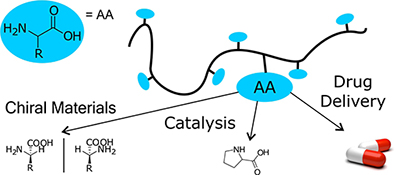
Amino acids are nature’s highly functional building blocks. The design and synthesis of polymers functionalized with amino acids enable the production of truly biomimetic materials. Herein, we focus on the amino acids as a functional moiety that can be used strategically to achieve targeted properties in functional polymers, and summarize their emerging applications.
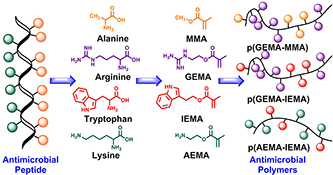
Naturally occurring AMPs have been honed by Mother Nature to give highly safe and efficacious antimicrobials that form part of many organisms’ immune systems. By studying these peptides, synthetic polymer mimics can be designed that hold potential as anti-infective therapeutics. This review traces the development of the antimicrobial polymethacrylates.
CH15787High Glass Transition Temperature Fluoropolymers for Hydrophobic Surface Coatings via RAFT Copolymerization
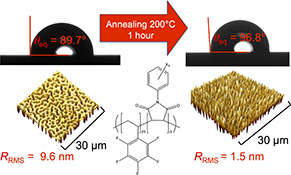
A series of copolymers of 2,3,4,5,6-pentafluorostyrene (PFS) and N-phenylmaleimide (NMI) were prepared by RAFT polymerization to yield materials with both a high glass transition temperature (Tg) and a hydrophobic nature. A significant increase in Tg was measured relative to predicted values due to π–π interactions between adjacent PFS and NMI units in the polymer chain. Hydrophobicity of the surface coatings was largely independent of the copolymer composition.
CH15806Stability of Polymer Interlayer Modified ITO Electrodes for Organic Solar Cells
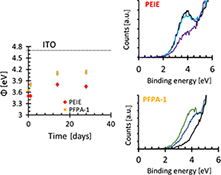
Work function stability of indium-tin-oxide (ITO) electrodes modified using polymeric interlayers of ethoxylated polyethylenimine (PEIE) and poly(3,3′-([(9′,9′-dioctyl-9H,9′H-[2,2′-bifluorene]-9,9-diyl)bis(4,1-phenylene)]bis(oxy))bis(N,N-dimethylpropan-1-amine)) (PFPA-1) is reported. Origin of work function change as a result of aging, is understood by analysing the changes in the interfacial dipole and the molecular realignment of polymers on the surface.
CH16033Phase Separated Block Copolymer Particles with Tuneable Morphologies: Striped, Onion, and Patchy Particles
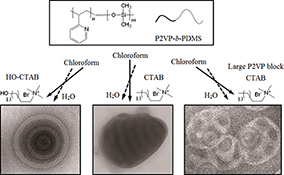
Morphologies of poly(2-vinyl pyridine)-block-poly(dimethylsiloxane) (P2VP-b-PDMS) diblock copolymers can be tuned by controlling the interfacial energy using functional surfactants. For symmetric block copolymers, onion-like or axially stacked particles can be engineered depending on the composition of surfactant mixtures. Utilising asymmetric copolymers with a dominant P2VP domain non-conventional patchy particles are observed.
CH15569Synthesis and Binding Affinity of Fluorine Containing NG-acyl and -sulfonyl BIBP3226 Derivatives: Ligands for the NPY Y1 Receptor
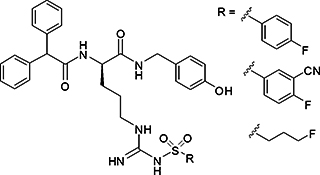
Neuropeptide Y (NPY) receptors are abundant in a range of tumours hence are a molecular target for tumour imaging and therapy. A series of NG-substituted derivatives of the NPY receptor antagonist, BIBP3226, were prepared aiming to improve its current usability and to incorporate a positron-emitting radioisotope for development in positron emission tomography radiopharmaceuticals.
CH15174Prospects of Spin Catalysis on Spin-Polarized Graphene Heterostructures
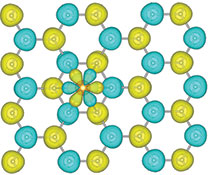
Ab initio density functional theory calculations were used to examine the feasibility of running spin-catalytic reactions on graphene 2D ferromagnetic heterostructures. The spin states of the substrates strongly influenced parameters of Ni adatom extreme points of potential energy surfaces on graphene. This phenomenon offers unique possibilities to control chemical reactions on graphene deposited on different ferromagnetic supports.
CH15596Ionic Thiourea Organocatalysis of the Morita–Baylis–Hillman Reaction
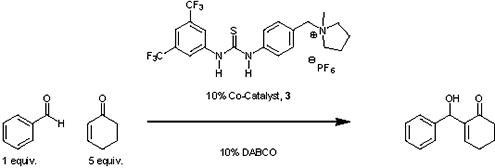
An ionic thiourea-based organocatalyst has been shown to promote a 1,4-diazabicyclo[2.2.2]octane, (DABCO) catalyzed Morita–Baylis–Hillman reaction between benzaldehyde and cyclohex-2-en-1-one. Entrainment of the ionic thiourea co-catalyst in the ionic liquid N-butyl-N-methylpyrrolidinium bistriflimide, [BMPyr][N(Tf)2], facilitates catalyst recycling and affords very good yields with reduced reaction times through use of microwave heating.
CH15627Synthesis and Photocleavage of Quinoline Methyl Ethers: A Mild and Efficient Method for the Selective Protection and Deprotection of the Alcohol Functionality
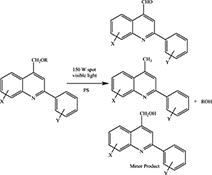
The synthesis and photocleavage of quinolinyl methyl ether-protected alcohols is reported in this study. Photocleavage of the quinolinyl methyl ether moiety proceeded under visible light with the formation of the charged quinolinyl radical intermediate through a single-electron transfer in the presence of a photosensitizer dye leading to the deprotected alcohol in excellent yields
CH15667A Concise Synthesis of Racemic Lorcaserin

A new and concise synthesis of racemic lorcaserin was described. Key intermediate asymmetrical imide 11 was prepared by the reaction of nitrile and acid, and efficiently reduced by NaBH4, AlCl3, and trimethylsilyl chloride into amine 8a, which could be cyclized into racemic lorcaserin ((±)-1).
CH15568Anisotropic 2s2p Orbitals as Simple Descriptors of the Chirality of Carbon Centres
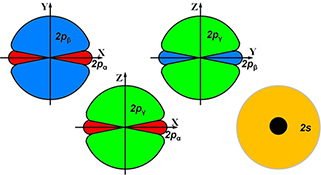
As a breakthrough in quantum chemistry, anisotropic 2p electronic orbitals are introduced instead of isotropic ones in the X, Y and Z directions. A pair of 2pα are two one-dimensional sticks (red); 2pβ are two flat sectors (blue); 2pγ are two hemispheres (green); and 2s orbitals are two spheres. They are the root of molecular chirality when fixed by four different substituents and may account for the configurations and reaction mechanisms of various organic molecules.
CH15769Rapid and Facile Synthesis of Rod-Like Ordered Mesoporous Carbon Material for Dye Adsorption from Aqueous Solution
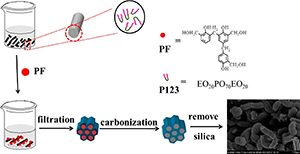
A rapid and facile synthesis method for rod-like ordered mesoporous carbon material (OMC) was developed, in which the phenolic resin was used as the carbon source and the precursor solution of rod-like SBA-15 was employed as a hard-template. This method skipped several processes related to the preparation of SBA-15. Furthermore, the as-synthesized OMC showed excellent capacity for dye adsorption from aqueous solution.
CH15495Zinc Oxide Nanoparticles-Immobilized Mesoporous Hollow Silica Spheres for Photodegradation of Sodium Dodecylbenzenesulfonate
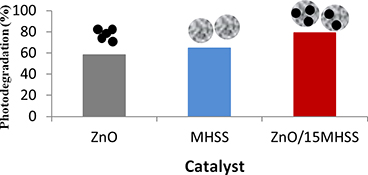
ZnO-Immobilized mesoporous hollow silica spheres photocatalysts were synthesized via impregnation method. These materials have higher activity toward photodegrading SDBS when compared with the bare ZnO nanoparticles. The photocatalytic reaction followed the second-order kinetics model.
CH15662Solvothermal Synthesis of Single-Crystal Magnetite Hollow Sub-Microspheres: A Novel Formation Mechanism and Magnetic Properties
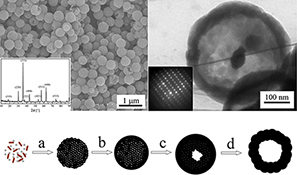
Single-crystal magnetite hollow sub-microspheres with a narrow diameter distribution are synthesized through a simple solvothermal process in ethylene glycol in the presence of urea and a small amount of water. The determining role of water in the solvothermal synthesis is studied. A novel formation mechanism for the solvothermal synthesis of magnetite hollow sub-microspheres is proposed based on Ostwald ripening.
CH15675A Facile and Efficient Method for the Formation of Unsymmetrical Ureas Using DABAL-Me3

A practical synthetic method for unsymmetrical ureas from 2,2,2-trichloroethyl carbamate compounds using bis(trimethylaluminum)-1,4-diazabicyclo[2.2.2]octane (DABAL-Me3) is developed. The reaction protocol provides the synthesis of a variety of unsymmetrical ureas such as tri- and tetrasubstituted ureas.
CH15746Polyelectrolyte-Assisted Immobilization of Oil-Based Nanocapsules on Cotton Fabric
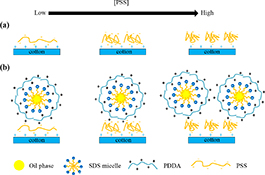
The facile and effective immobilization of nanocapsules containing the oil-based finishing agent on the cotton fabric was proposed using poly 4-styrenesulfonic acid (PSS) binder. The higher PSS amount, the higher quantity of immobilized nanocapsules was obtained. This method was performed at the ambient temperature using low concentrations of non-toxic chemicals.



